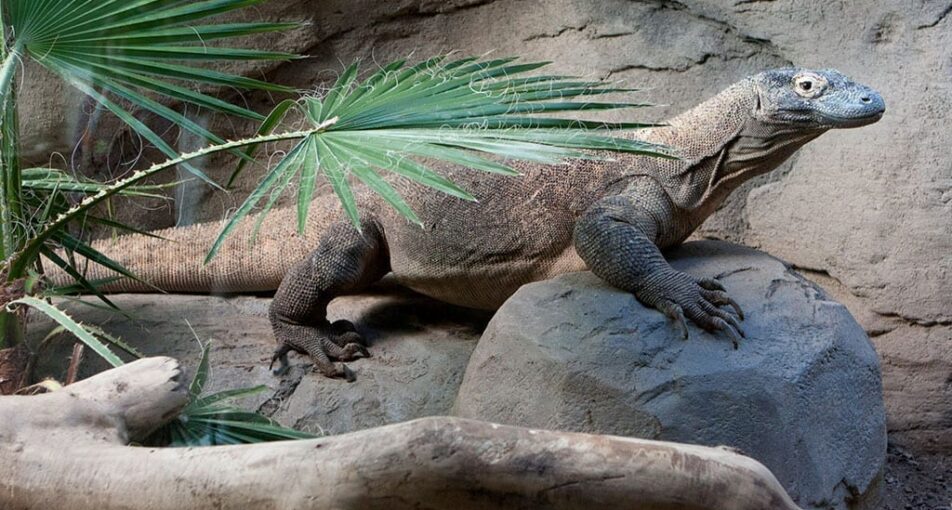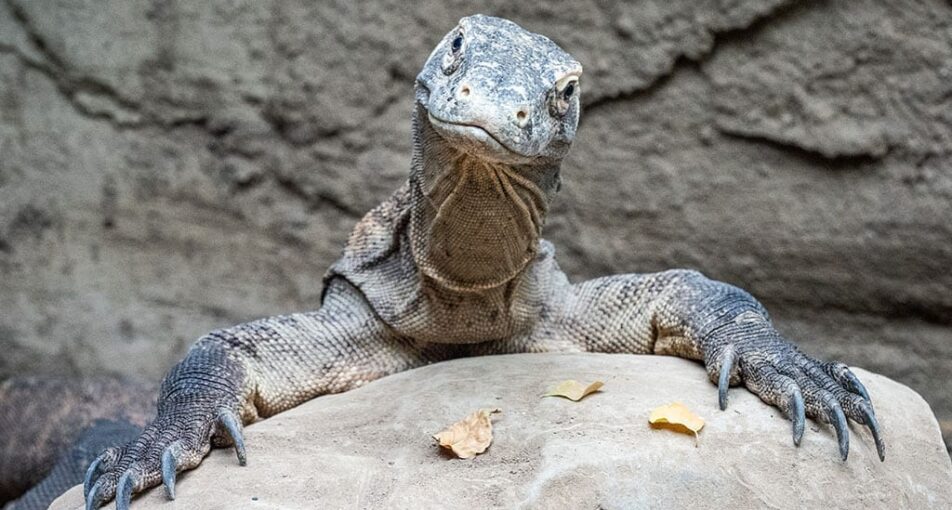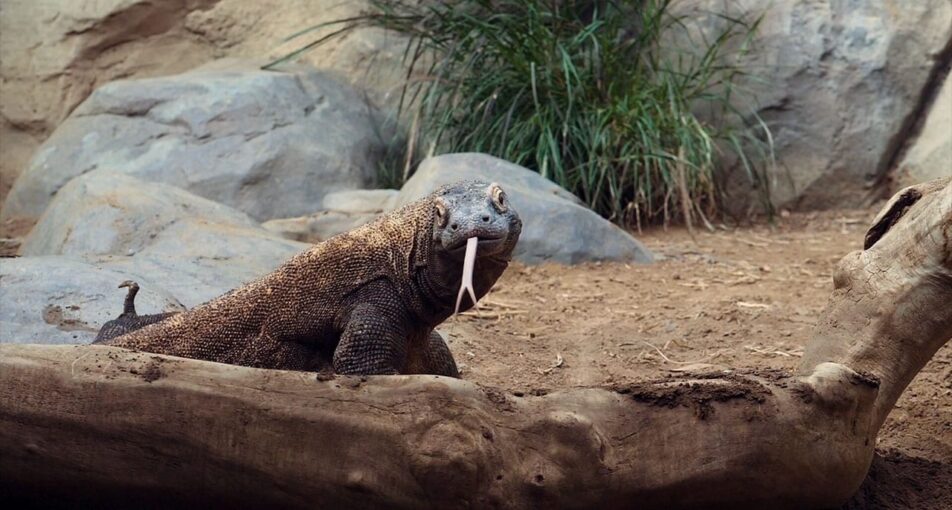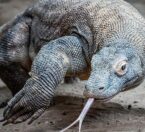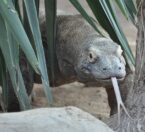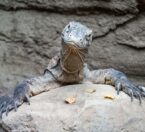The Komodo dragon’s sense of smell is their primary method of detecting food. Using their forked tongues, they test the air for the scent of warm-blooded animals. They have a Jacobson’s organ on the roof of the mouth that analyzes the information from the tongue and signals the direction of potential prey. Their sense of smell is so acute, they can detect the smell of dead or dying animals up to five miles away.
Classification
| CLASS: | Reptilia |
| ORDER: | Squamata |
| FAMILY: | Varanidae |
| GENUS: | Varanus |
| SPECIES: | komodoensis |
Habitat & Range
This reptile is found in dry open grassland, savanna and tropical forest at low elevations.
Komodo dragons are found on a few small islands east of Bali and south of Borneo including Komodo Island, Flores Island, Rinca Island and Padar Island.
Location


Adaptations
- All the Better to Eat You With…
- Komodo dragons have 60 razor sharp teeth up to one inch (2.5 cm) long. Lost or damaged teeth are constantly replaced. Dragons can go through four or five sets of teeth in their lifetime. Their teeth allow dragons to tear off large chunks of flesh which they swallow whole. Their sharp claws are used to attack and hold prey.
- Beware the Bite
- Many lizards eat plants but Komodo dragons are carnivores and mainly eat carrion, but also ambush large prey. They use a stealthy approach when hunting prey, using their long claws and sharp teeth to attack the unwary animal as it passes by. If the prey does not die from the initial attack, the dragon follows the injured animal until it dies due to blood loss or infection. Komodo dragon saliva contains 50 different strains of toxic bacteria that cause deadly infections in the prey animal. Attracted by the smell, several dragons converge on dead or decaying animals. The largest male dragons eat first, followed by smaller males and females, and finally by the juvenile dragons that descend from the safety of the trees to eat whatever remains.
- Primary Sense
- The Komodo dragon’s sense of smell is their primary method of detecting food. Using their forked tongues, they test the air for the scent of warm-blooded animals. They have a Jacobson’s organ on the roof of the mouth that analyzes the information from the tongue and signals the direction of potential prey. Their sense of smell is so acute, they can detect the smell of dead or dying animals up to five miles away.
Physical Description
- Male Komodo dragons are up to 10 feet (3 m) long; females are up to eight feet (2.4 m) long.
- They weigh up to 176 pounds (80 kg).
- The adults are covered with brown or gray scaly skin; juveniles are dark green with yellow and black bands.
- They have massive claws and powerful legs.
- They have sharp, serrated teeth.
- Their powerful, muscular tail is as long as the body.
Diet
What Does It Eat?
In the wild:
Adults ear water buffalo, pigs, deer, feral dogs, venomous snakes and juvenile dragons; juvenile dragons eat small lizards, eggs, grasshoppers and beetles. At the zoo: Rats, capelin.
At the zoo:
They get rodents of appropriate size for the animal, and then when adults, rabbits, goat quarters etc as available and sized appropriately.
What Eats It?
Adults are top predators but juvenile dragons are preyed upon by adult dragons, feral dogs, wild boars, civet cats and snakes.
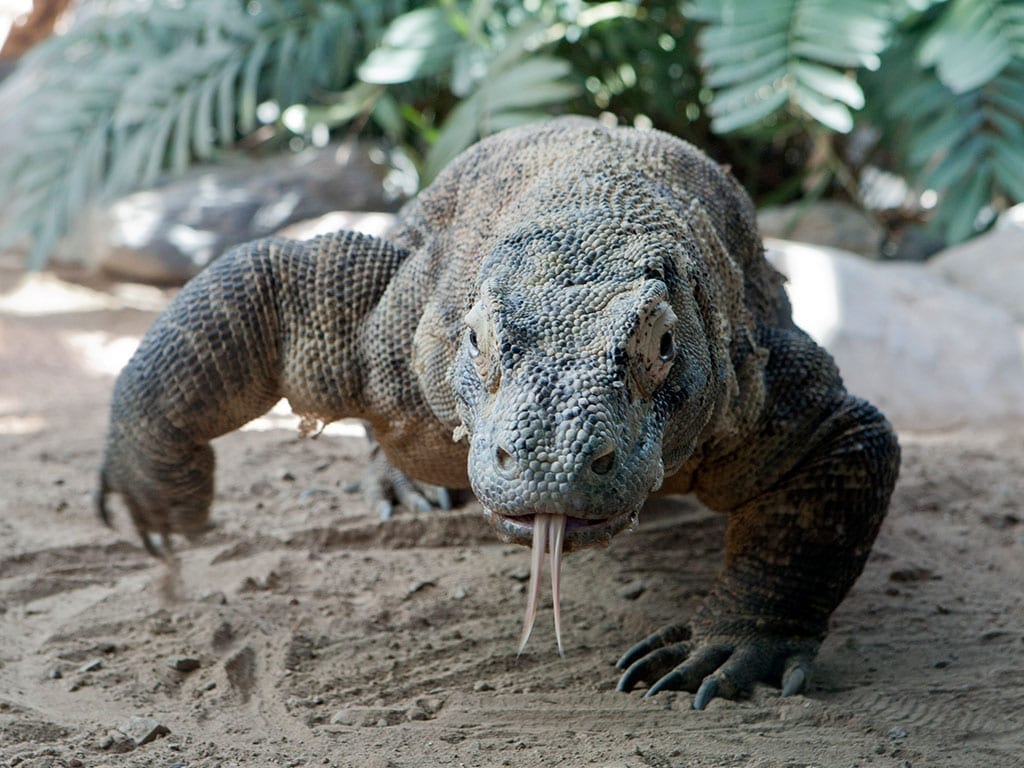
Social Organization
Komodo dragons are solitary animal except during breeding although groups of dragons may gather to feed at a kill.
Life Cycle
During the breeding season, males compete for breeding rights to receptive females. The dragons wrestle in an upright position using their tails as props. The successful male stimulates the female by chin rubbing and tongue flicks to the head and shoulders before mating. After mating, the male stays near the female for several days to prevent other males from mating with her. The female deposits up to 30 eggs in a depression and buries them. The eggs hatch in eight to nine months. Newly hatched Komodo dragons receive no parental care and in fact immediately climb nearby trees to escape falling prey to adult dragons or other predators. The hatchlings are about 14.8 inches (37 cm) long. The young dragons spend their first three or four years in the trees until they reach about four feet (1.2 m) in length. Komodo dragons are mature at about five years of age. Komodo dragons can live over 50 years.

